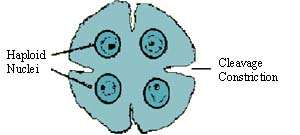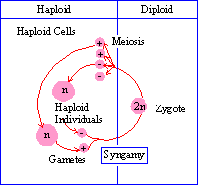|
PinkMonkey Online Study Guide-Biology

Figure 6.6 Simultaneous cytokinesis by cleavage constriction
Centriole and aster : In animals, a centriole is present outside the nucleus. It divides into two during prophase-I and later on helps in the organization of the bipolar spindle as well as the asters (as in mitosis).
Anaphase-I : The homologous chromosomes are pulled away from each other and finally separate completely (terminalization is completed). In other words, the sets of maternal and paternal chromosomes separate (segregate) and start moving towards opposite poles. This is due to the shortening of the chromosomal fibers.
Telophase-I : The two sets reach the opposite poles. The chromosomes, each with two chromatids and one centromere, become thin and long. A nucleolus is organized. Each nucleus is haploid as it has received only one set of chromosomes. Hence M-I is called reduction division.
Interkinesis : The time interval between M-I and M-II
is called interkinesis.
Meiosis-II (M-II or Second meiotic division)
Second meiotic division is similar to mitosis i.e. it
is an equational division in which there is duplication of the
chromosomes. The two nuclei formed after M-I divide during M-II and
produce four haploid nuclei.
The various events in M-II are classified into Prophase-II, Metaphase-II, Anaphase-II and Telophase-II. Both the nuclei divide simultaneously and all the changes during each phase are similar in both.
Prophase-II : The chromosomes again become shorter, thicker and distinct. Each chromosome has two sister chromatids joined by a centromere. The nuclear envelope and the nucleolus disappear by the end of Prophase-II.
Metaphase-II : The bipolar spindle body is formed. Chromosomes are arranged along the equators in such a way that their chromatids are facing the opposite poles. The centromere of each chromosome is connected with both the poles by chromosomal fibers.
In animals, centriole is present outside the nucleus and participates in the formation of bipolar spindle and asters.
Anaphase-II : During early anaphase-II, the centromere of each chromosome divides longitudinally into two. Therefore each chromosome is divided into two halves (chromatids) or daughter chromosomes.
During late anaphase-II, the two sets of daughter chromosomes are pulled away from each other and move towards the opposite poles.
Telophase-II : The sets of chromosomes reach the opposite poles and a new nucleus is organized at each pole. In all, four daughter nuclei are formed. Each nucleus has half the number of chromosomes as compared to the original mother nucleus. These nuclei also differ from each other in the structure and characters of chromosomes. This is because of the crossing over during prophase-I.
Cytokinesis : This is the division of the cell cytoplasm. It follows the nuclear division and may be successive or simultaneous.

Figure 6.7 Zygotic Meiosis in some algae
Table of Contents
6.0
- Introduction
6.1 The Cell Cycle
6.2
Mitosis
6.3 Meiosis
Comparison
between Mitosis & Meiosis
Chapter 7
|
|